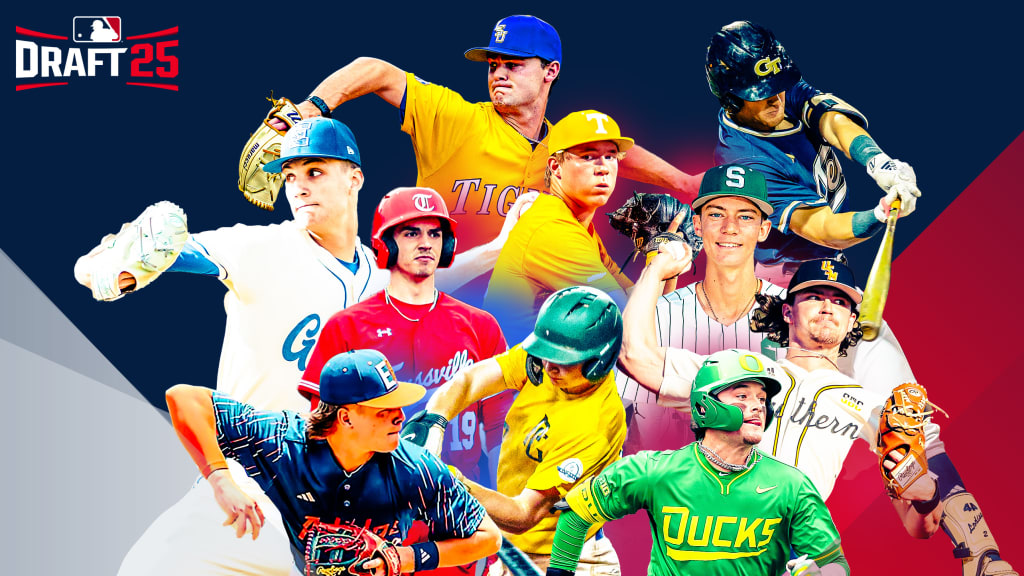
MLB Pipeline expanded its Draft rankings from 100 to 150 last week, which brought plenty of changes to the preseason list. While high school infielder Ethan Holliday remains No. 1, there's a bevy of new faces at the top.
On the last episode of the MLB Pipeline Podcast, Jim Callis, Jonathan Mayo and Jason Ratliff discussed those changes, with a focus on 10 players who are the fastest risers. Five players, in particular, have cemented their place for first-round consideration, while another five are trending up and could join them before July's Draft.
The rising prospects are an equal mix of high schoolers and college players, although there's a clear emphasis on pitchers and shortstops. Below is an abbreviated look at the players, including where they've jumped from in the rankings, with a full breakdown of each player available on the podcast.
Kade Anderson, LHP, Louisiana State (44 to 9)
Callis: LSU kind of eased him back (after Tommy John) as a midweek starter, weekend reliever. He looked very good in the postseason coming out of the bullpen. Guys were hoping he'd make a leap, but you had to see it. He hadn't started regularly. He's been very, very good. ... It's not overpowering radar-gun stuff, but the fastball plays really up. It's 92 to 94 to 97, but it's got big carry. He had a curveball last year. He switched to more of a high-spin slider that looks like it could be a potential plus pitch this year. He's got a changeup that has become better as he's used it more often. He's throwing plenty of strikes. You're wondering if there might be another uptick in stuff after it improved this year.
Liam Doyle, LHP, Tennessee (75 to 10)
Callis: He's had the most untouchable fastball in college baseball this year. He's led Division I in strikeouts for most of the year. Sits mid-90s, peaks at 99, and it comes out of a high release point and seems to explode at the top of the strike zone. Guys just cannot hit it at all. ... He could have three 55 pitches and a plus plus fastball. But it's a really unorthodox delivery with a lot going on. Nobody can come up with a comparison. Name a big league starter that has a delivery like that, there isn't an obvious answer to that question. He doesn't necessarily throw with a lot of effort, but he throws with a lot of intent, if that makes sense.
More from MLB Pipeline:
• Top 100 prospects | Stats | Video | Podcast | Complete coverage
Steele Hall, SS, Hewitt-Trussville HS (Ala.) (NR to 13)
Callis: Hall was part of the 2026 Draft until he reclassified last November. ... He has a really good swing in batting practice and drives the ball from gap to gap and works around the ballpark. And then in games this spring, he'll tend to hunt home runs a little bit. His offensive ceiling isn't as high as the other two guys, [JoJo] Parker and [Daniel] Pierce, but the bat is going to be fine. It's just not the focal point of his game. He's a 70-to-80 runner, and he's a really good defensive shortstop. He's not going to have to move off shortstop. You know he's sticking there. It's a solid arm.
JoJo Parker, SS, Purvis HS (Miss.) (86 to 14)
Callis: He just keeps getting stronger and more athletic as he continues to mature physically. People compared him to Carter Johnson, who signed for well over slot, $2.8 million, as a second-rounder by the Marlins. And now, the same scouts are saying that's not a great comparison because he's got a lot more power than Carter Johnson. JoJo Parker's got a chance to be a plus hitter with solid power. His arm has even gotten better too. His actions and quickness are just average, so he's probably more of a second baseman or third baseman.
Daniel Pierce, SS, Mill Creek HS (Ga.) (57 to 18)
Callis: He's a good hitter. It's probably 15-homer power, maybe a little bit more. He can run, not as quick as Steele Hall, but a plus runner, and he's a solid defender, too. So he kind of combines both. You're going to get some offense, and you're going to get some speed and defense too. As people have seen him more, he's stood out more. With those three shortstops, I don't hear Pierce's name in the top 10. I hear a little Steele Hall up there, and I hear a little JoJo Parker. But I also could see a scenario where Daniel Pierce goes over both of them because he's probably the most well-rounded of the three.
Alex Lodise, SS, Florida State (NR to 53)
Mayo: He's played a good shortstop, he's hit for average, he's hit for power. It's one of these weird things that, when you dig down into the data, some of it doesn't make sense. There's some swing-and-miss. The strikeout rate's not bad. It's much better than it was, so there's improvement there. He chases a little too much, but he's hitting well over .400 with a ton of power. I'm not sure about the sustainability, but he's added strength and it looks like he's going to play shortstop going forward, when that was maybe a question before.
JB Middleton, RHP, Southern Miss (NR to 31)
Callis: He might be the fifth-best college pitcher after the four we've already discussed in the top 10. He's not a real big guy, he's 6-foot or so, wasn't a big-time recruit, but Southern Miss does a really good job. ... He's got really good stuff. It's 93 to 95 to 97, and he's got the feel for his fastball to run it or sink it or carry it. He can get fastball misses in the zone, he can get chases, it's hard to lift the ball in the air. His slider is a really overpowering pitch, upper-80s velocity with two-plane depth. He'll turn it into a cutter at times. He's got a plus 86-88 mph changeup that he'll flash that tumbles and fades. He's athletic and throws strikes.
Jordan Yost, SS, Florida HS (NR to 61)
Mayo: Coming into the spring, I don't know that even he was thinking about the possibility of starting his pro career. Some of that is because he's got a strong commitment to the University of Florida, where his older brother, Hayden, is a player, so that might be tough to overcome anyway. But he really lacked strength and impact earlier. A ton of contact, a really elite level of bat-to-ball skills. He's added some strength. Now the power is still a much deeper projection, but that's gotten better. He runs really well. He's got really good instincts and baseball IQ. He's a shortstop long term, so he's suddenly become interesting as a top two- or three-round kind of guy.
Jack Bauer, LHP, Lincoln-Way East HS (Ill.) (NR to 32)
Callis: He kind of blew up on Twitter because he was clocked throwing 102 mph, which no high school left-hander ever has. Very few pro left-handers ever have. He's a little bit of a tough guy to figure out. ... It's been short stints, two-three innings at a time. He missed his start last week -- it's not supposed to be anything serious -- but when guys make the velo jump, you wonder a little bit about the long-term health. People are trying to figure out, as exciting as 102 is, what does it mean? He's got a better slider now, low 80s with sweeping action to it. He's showing more feel for a changeup. He's throwing a lot more strikes. ... People will like to see as much of him as they can and try to wrap their heads around exactly what Jack Bauer has become.
Mason Neville, OF, Oregon (NR to 62)
Mayo: He hit for power last year with a ton of swing-and-miss. This year, there's a lot more power. He's got 21 homers in 41 games. There's still swing-and-miss, but he just keeps getting better and better. ... The strikeout rate is considerably lower. He's drawing more walks. I was talking to a scout in the Pacific Northwest who says he's been hitting lefties better now. ... I have a feeling that when we expand to 200 and rerank, he's going to keep moving up, assuming he keeps performing the way he's been performing. College power bats like that, if he keeps answering questions about the holes in the swing and the strikeout rate, he's going to move up.


